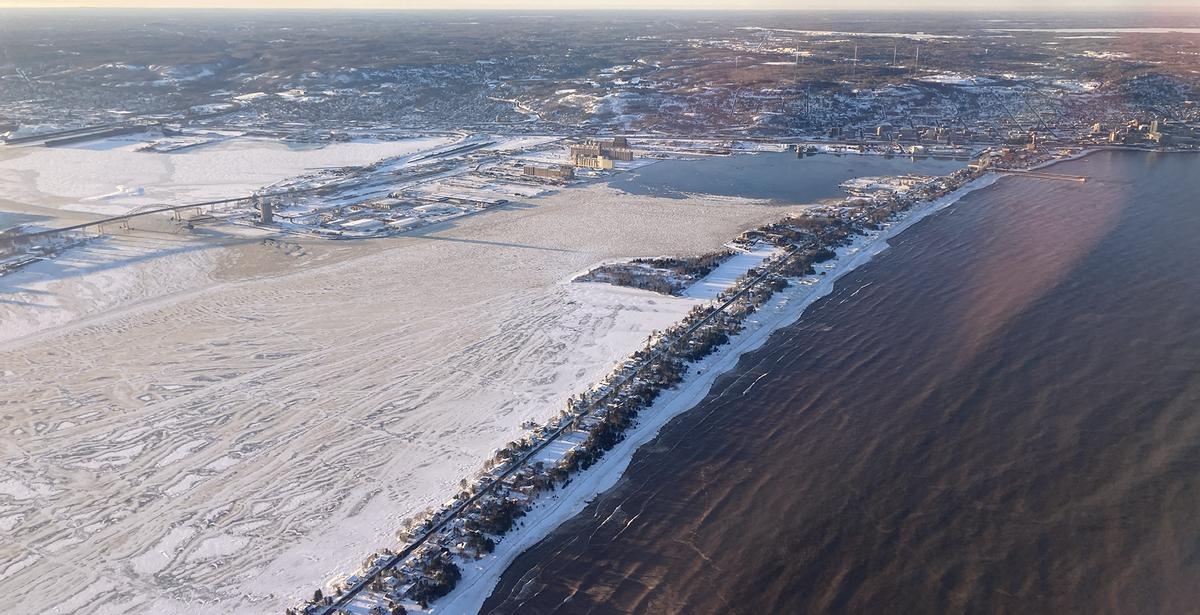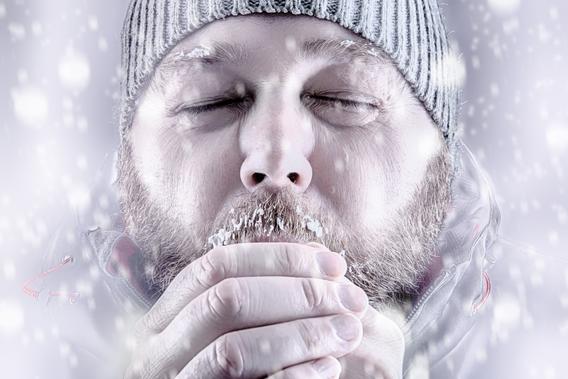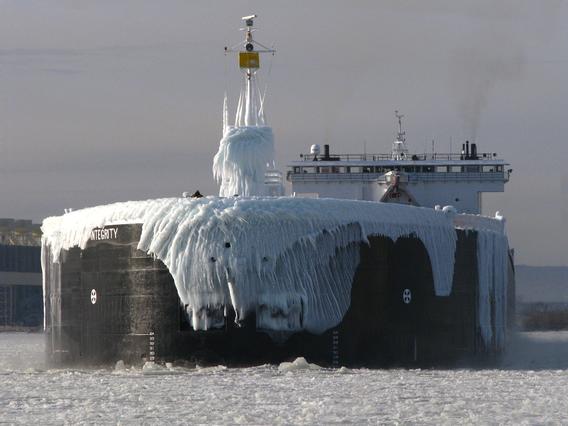
The open water of Lake Superior (right) and the frozen water of the Duluth-Superior harbor (left). Image credit: M. Thoms
Joys and pains of thicker snow and thinner ice
I’ve been hearing about the joy Minnesotans are getting from snow this winter and the pain resulting from thin ice. Despite warm weather in early- to mid-January, good snow conditions stretch far south of the Twin Cities.
- Dean Sunderlin, chair of the Circle Lake Improvement District, reports great snowshoeing around Rice County this winter.
- An internet search for “thin ice vehicles minnesota” yields numerous stories of vehicles falling through the ice around the state.
Thicker snow and thinner ice are related. Thick snow cover and warm winter weather combine to yield thin and variable ice cover on lakes.
Float your truck on ice
Remember that when you drive your truck on a frozen lake, you are counting on the ice to bend enough to act like a boat and float your truck. The average pickup truck weighs about 7,000 pounds so you have to bend the ice enough (without cracking it) to make a dent that would contain at least 1,000 gallons of water, which is equivalent to the volume of about 24 bathtubs.
Hypothermia
If you do plan to drive or be on or near lake ice, I encourage you to review our hypothermia information. You typically have less than two minutes to escape a sinking vehicle so seatbelts need to come off fast, and door locks and windows need to be opened immediately because they fail once submerged. In winter, I carry a hand ax to break windows and a hypothermia rescue kit in my vehicle. If you or someone else is immersed in winter lake water, get help immediately. The stages of hypothermia are cold - shiver - stumble - bumble - sleep - die. I keep this short link on my phone so I have it as a quick reference. I encourage you to do the same: https://z.umn.edu/shiver
Thin ice is good for shipping
The low ice cover on Lake Superior so far this winter has been frustrating for ice anglers but good for maritime shipping. The last laker out of the Port of Duluth-Superior this year was the latest departure from the port since 1975. A news release from the Duluth Seaway Port Authority reviews the astounding numbers for the 2022 shipping season. Few people outside the transportation and shipping industry are likely aware that around 800 vessels move 35 million short tons (70 billion pounds) of cargo through the Port of Duluth-Superior annually, which makes the port the largest tonnage port on the Great Lakes.
Floating the Great Wall of China
I got to thinking about comparisons to Duluth's port tonnage. The total weight of this season's cargo is only 40% less than the weight of the Great Wall of China and three-and-a-half times the weight of the Egyptian Pyramids (six million tonnes).
Minnesota Sea Grant Maritime and Hazmat Transportation Program
Maritime shipping supports around 8,000 jobs and brings $1.4 billion to Minnesota’s economy. Through the great work of our Sea Grant Great Lakes Transportation Extension Educator Kelsey Prihoda, we are proud to assist the maritime transport industry in keeping communities and economies resilient and vital.
Practical advice to make your shoreline property more fish-friendly
Join me at noon, March 2, 2023, for the Minnesota Sea Grant-sponsored Itasca Waters Practical Water Wisdom Series presentation “Water Plants and Woody Debris in Shallow Water: Friend or Foe?” by Greg Sass of the Wisconsin Department of Natural Resources. Greg’s practical advice will focus on conserving and enhancing fish habitat that benefits lake resources. The presentation is free, but registration is required.
Staff Milestones
Don Schreiner. It was a happy day six years ago this month when Don Schreiner offered to come out of retirement from the Minnesota Department of Natural Resources to assist Minnesota Sea Grant’s fisheries and aquaculture program. Little did he know then that he’d play a significant role in rebuilding that program.
- Long before Don volunteered for MNSG in 2014, he was supported by Minnesota Sea Grant as a graduate student. He went on to be a key part of MNDNR fisheries on Minnesota’s portion of Lake Superior. He played a pivotal role as a member of the MNSG Advisory Board and he volunteered to help answer calls from the public to MNSG about fish. Don stepped in when we started the Great Lakes Aquaculture Collaborative (GLAC) and along with Marie Thoms, our communications manager, was instrumental in making GLAC a region-wide success and instrumental in onboarding our then-new fisheries and aquaculture extension educator Amy Schrank as the GLAC principal investigator. In 2023, through Don and Amy’s efforts sustainable fisheries and aquaculture now makes up about 30% of our research and extension efforts, most of it generated through extramural funding.
- In 2022, Don played another key role for MNSG as our interim extension program leader, stepping into that role for a six-month term (July-December 2022). Don brought his decades of supervision and management experience, humor, and practical approach to this role and influenced our extension program in positive ways.. We’re thrilled that Don will be returning to his part-time position as a fisheries specialist continuing to assist MNSG as our programming grows and strengthens. His graciousness in transitioning among roles in MNSG is a worthy life and business lesson for all.
Amy Schrank. Three years and two days ago, just before the pandemic changed all our lives, Amy Schrank joined our staff as a fisheries and aquaculture extension educator. I did not see her in person, I think, until we had worked together for nearly two years! Amy has been extremely productive since joining MNSG and has excelled in building partnerships both in Minnesota and throughout the Great Lakes region. On January 1, 2023, Amy started a new position as the MNSG Extension Program Leader. MNSG is a systemwide program of the University of Minnesota and Amy’s enthusiasm, organizational skills, and professionalism strengthen the ties among our UMN and UMD staff and campus colleagues. In addition to her extension work, Amy is an accomplished research scientist and wonderful professor who especially enjoys teaching field courses. It is fabulous to have her in our leadership team.

